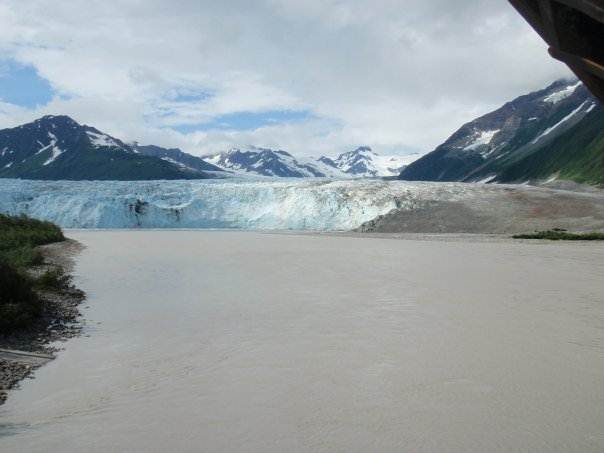29 August 2011
Receding Alaskan glaciers could disrupt gulf food chain
Posted by kramsayer

Alaska's Copper River carries iron-containing sediments from glaciers, like Child's Glacier seen here, to the Gulf of Alaska. If the glaciers recede, however, the availability of nutrients in the gulf could change. (Credit: Andrew Schroth)
When Alaskan glaciers move, they grind away at the underlying rocks. The scouring produces sediments that contain iron – an essential nutrient to the rich coastal ecosystem of the Gulf of Alaska.
But if global temperatures continue to warm and the glacial landscape melts into forested land, the type and amount of iron coming from Alaskan rivers could change, with unknown but potentially significant consequences for the downstream ecosystem.
In the Copper River Basin, iron-rich sediment called glacial flour is flushed down watersheds from glaciers to the gulf, where they help nourish phytoplankton populations. The plankton, in turn, help fuel organisms higher up in the food chain, including the famously tasty Copper River wild salmon.
In a recently published Geophysical Research Letters paper, Andrew Schroth, a geochemist with the United States Geological Survey in Woods Hole, and his colleagues analyze the different forms of iron that are carried from a range of ecosystems in the Copper River watershed. The 68,635 square-kilometer (26,500-square-mile) watershed has streams that start from glaciers, glacial lakes and forested areas.
If warming temperatures continue in the region, “we can speculate that over very long time scales, as these glaciers continue to recede, you’ll have an increasing fraction of forested areas,” Schroth says.
And with that, he says, will come changes in the type and availability of iron that enters the Gulf of Alaska.
In glacial environments, the moving ice breaks up rocks and releases fine-grained glacial flour that reflects the mineral makeup of the bedrock below the ice. In the Copper River watershed, that means lots of iron-bearing silicate minerals.
But when the rivers and streams pick up iron from forested areas, much of the iron has been chemically altered by biogeochemical processes, and more of it dissolves in the water due to organic compounds from the forest and its soil.
If glaciers continue to shrink, glacial weathering would slow down, leading to less sediments and particulate iron flowing from Alaskan rivers, Schroth says. While the source of iron would change, from glaciers to forests, researchers still need to tease out the effects of the switch, which could echo through the ecosystem.
In some areas of the ocean, including the offshore Gulf of Alaska, the amount of iron available determines how much phytoplankton will grow, he says. Fish, including salmon, need a healthy phytoplankton population. And many Alaskans, from commercial fishermen to those in the tourist trade, depend on those salmon.
“It’s a very important ecosystem, there’s a lot of people who rely on that fishery,” Schroth says.
![]() Schroth, A., Crusius, J., Chever, F., Bostick, B., & Rouxel, O. (2011). Glacial influence on the geochemistry of riverine iron fluxes to the Gulf of Alaska and effects of deglaciation Geophysical Research Letters, 38 (16) DOI: 10.1029/2011GL048367
Schroth, A., Crusius, J., Chever, F., Bostick, B., & Rouxel, O. (2011). Glacial influence on the geochemistry of riverine iron fluxes to the Gulf of Alaska and effects of deglaciation Geophysical Research Letters, 38 (16) DOI: 10.1029/2011GL048367
– Kate Ramsayer, AGU science writer










 GeoSpace is a blog on Earth and space science, managed by AGU’s Public Information staff. The blog features posts by AGU writers and guest contributors on all sorts of relevant science topics, but with a focus on new research and geo and space sciences-related stories that are currently in the news.
GeoSpace is a blog on Earth and space science, managed by AGU’s Public Information staff. The blog features posts by AGU writers and guest contributors on all sorts of relevant science topics, but with a focus on new research and geo and space sciences-related stories that are currently in the news.